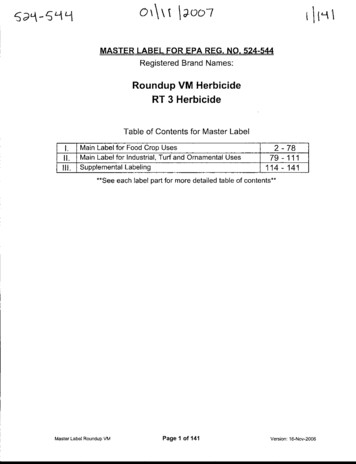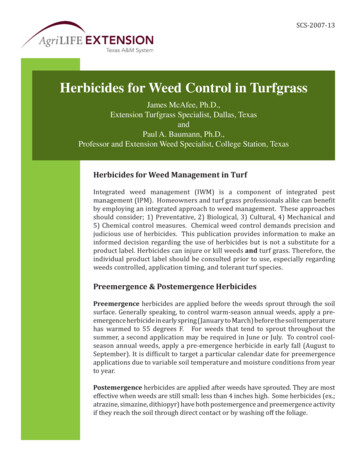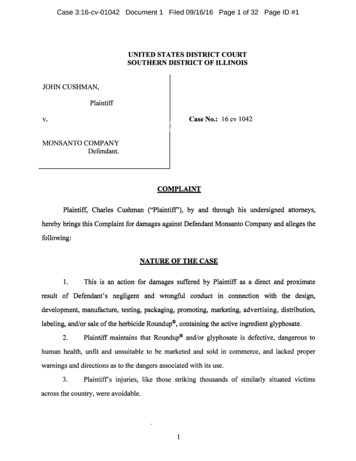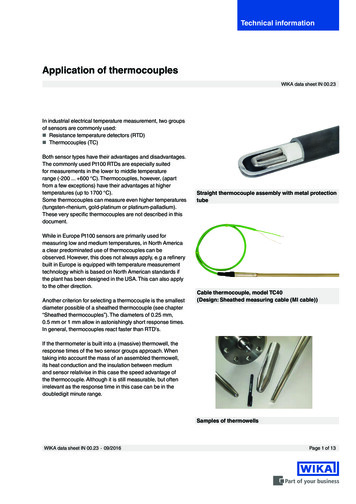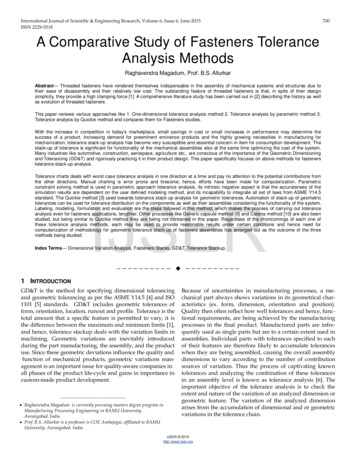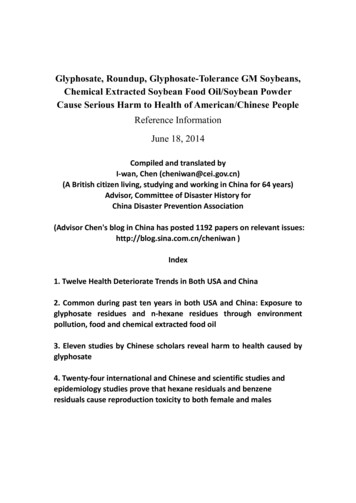
Transcription
Glyphosate, Roundup, Glyphosate-Tolerance GM Soybeans,Chemical Extracted Soybean Food Oil/Soybean PowderCause Serious Harm to Health of American/Chinese PeopleReference InformationJune 18, 2014Compiled and translated byI-wan, Chen (cheniwan@cei.gov.cn)(A British citizen living, studying and working in China for 64 years)Advisor, Committee of Disaster History forChina Disaster Prevention Association(Advisor Chen's blog in China has posted 1192 papers on relevant issues:http://blog.sina.com.cn/cheniwan )Index1. Twelve Health Deteriorate Trends in Both USA and China2. Common during past ten years in both USA and China: Exposure toglyphosate residues and n-hexane residues through environmentpollution, food and chemical extracted food oil3. Eleven studies by Chinese scholars reveal harm to health caused byglyphosate4. Twenty-four international and Chinese and scientific studies andepidemiology studies prove that hexane residuals and benzeneresiduals cause reproduction toxicity to both female and males
01 Twelve Health Deteriorate Trends in Both USA and ChinaTotal 17 Pages/Page 1Twelve Health Deteriorate Trends in Both USA and ChinaIndex1)USA Infertility Reaching 15%, China Closely Following InfertilityPatients Already Exceeding 50 Million2)Precocious puberty Rapidly Increase in both USA and China3)USA and China’s Children Asthma Incident Rate Increase Year byYear, Even if Air Quality is Improved4)USA and China’s Children with Chronic Diseases Rapidly Increase:The percentage of children with a current chronic disease rose to 25%in 2000-2006, the percentage of kids who had ever had a chronic illnessgrew to 52% in the same time in USA; In China, among children, youthand youngsters, incident rate of high blood pressure 9%, lipid disorders9.8%; based on survey in a number of provinces and cities, the incidentrate of pre-school age children with high blood pressure has alreadyreached 2% - 4%, and for school children already 4% - 9%!5)USA and China’s Patients Reason Unclear Increase During Past TenYears: 44% of Americans in 2005 had at least one chronic medicalcondition; Chinese residents with chronic disease is already 20%, thetotal number of determined diagnosed chronic patients reach 260million. During past ten years, there are 10 million chronic diseasepatents newly diagnosed each year.6) 8.3% Americans Have Diabetes, 9.7% Chinese Have DiabetesExceeding USA, the Risk is Very High for the “East Asian Weakling”Nightmare to Arrive Again for China!7)About one in every 33 babies (about 3%) is born with a birth defect,including approx 1% diagnosed with congenital heart defects in USA;the incidence of newborns with defects in China at present is about5.6%, the incidence of newborns with defects shows a trend of increase,increased from 877,000 in 1996 to 1.499 million in 2010, increase rate70.9%, with congenital heart disease becomes the number one defect!8) In USA, 78% increase of autism during 2007 - 2010, In China, autismrate in various areas has reached 1.5%, increased 10 times over 20 years,environmental, chemical, biological factors pointed as the culprit!9) Studies indicate possible links between Alzheimer’s disease andParkinson's disease, indicate 10% increase of annual incidence ofAlzheimer’s disease from 2000 to 2010 in USA; During the past 20 years(1998 - 2008), the average ages of Alzheimer’s disease patients hasadvanced from 65 years to 55 years; In the USA, 50,000-60,000 newcases of Parkinson disease are diagnosed each year; Based on mostconservative estimations, the incidence of Parkinson disease duringrecent 20 years in China has at least increased over 20 times!10) 1988-2004 USA incidence of primary liver cancer rapidly rose 90%,China’s liver cancer patients accounts for 54.26% of World’s total11) Children cancer increasing, especially leukemias, dramaticallyincreased in USA and China.12) Inflammatory Bowel Diseases rapidly increased 65 percent increasefrom 2000 to 2009, and increased 12 times in Shanghai from 2003 to2013!
01 Twelve Health Deteriorate Trends in Both USA and ChinaTotal 17 Pages/Page 21)USA Infertility Reaching 15%, China Closely Following InfertilityPatients Already Exceeding 50 MillionUSA infertility continue increases: 1995 10%; 2002 12%; 2009 15% 1995: According to National Survey of Family Growth, CDC 1995, approximately6.1 million women and their partners in the U.S. are affected by infertility, i.e.,10% of the total reproductive-age population. [2] 2002: Infertility affects about 7.3 million women and their partners in the U.S. -about 12% of the reproductive-age population (Source: National Survey of FamilyGrowth, CDC 2002). [3] 2009: Based on reported cases alone, almost 15 percent of adult Americansexperience infertility.Despite medical advances in the treatment of infertility overthe last two decades, that rate has not declined. In fact, most experts believe it hasrisen. Meanwhile, as the population of the United States has grown since 1970, thenumber of infertile couples has more than doubled. At present, an estimated 9million individuals are affected by infertility. [4]China:In China, the rate of infertile couples has reached 1/8, the number of infertilepatients has exceeded 50 million! Wu Jing-chun, Executive Committee Member of China Women Federation, formerDeputy Director of China Birth Planning Commission, on the “Sino-U.S. InfertileAcademic Forum” held in Dec., 2011 stated, due to various factors and workpressure, the ratio of infertile couples have reached 1/8, infertile patients haveexceeded 50 million in China, and are gradually increasing. She said, a birth crises isapproaching. [5] Prof. Chen Qiu-bo, honorary director, Hangzhou Guangren Infertility ResearchInstitute, in March 2012 pointed out: Statistics show, the infertility incidence amongappropriate age couples is sharply increasing, the average incidence in the country is12.5%-15%, meaning, one infertility among each 8 couples. [6][1] Brady E. Hamilton, Paul D. Sutton, Recent Trends in Births and Fertility RatesThrough June 2011http://www.cdc.gov/nchs/data/hestat/births june 2011/births june 2011.htm[2] women-health-info, Infertility ertility-general.html[3] American Society for Reproductive Medicine: Quick Facts About Infertilityhttp://www.asrm.org/detail.aspx?id 2322[4] A. Toth, Chapter 1 New Hope for Reproductive Health,Infertility Solution e-Health.html[5] China News Website, 2011-12-26, Executive Committee Member of China WomenFederation: Infertile patients have exceeded 50 million in 43.shtml[6] Zhejiang Online Health website, 2012 China Xihu Infertility Diagnosis & TreatmentSenior Forum is held in Hangzhou, tem/2012/03/20/018338078.shtml2)Precocious puberty Rapidly Increase in both USA and ChinaUSA:About 15 percent of American girls now begin puberty by age 7, according to a study of1,239 girls published last year in the journal Pediatrics. One in 10 white girls begindeveloping breasts by that age - twice the rate seen in a 1997 study. Among black girls,23 percent hit puberty by age 7. [1]China: The age of children in Guangzhou entering puberty has from average 13 years oldadvanced to 11 years; Based on study of a few thousand children in Guangdongprovince, the rate of "early puberty" has increased from 0.5% in 1994 increased to1.3% in 2004, the average rate of "early puberty" in China is 1%. [2] Early puberty rate survey of 23 thousand children in Zhejiang coast area reveals: 84children were identified early puberty, 9 boys and 75 girls, indicating rate of earlypuberty 0.38%, and girls with early puberty is 7.3 times of boys. The survey also revealed that the rate of early puberty is 0.45% in cities and towns,higher than 0.32% in rural areas; 0.50% in economic developed areas, and 0.32% inundeveloped areas; 0.52% in areas close to highways and industrial polluted areas,and 0.28% in less polluted areas.[1] Jennifer Ashton, Puberty starting earlier for many girls: study,CBS News, April 12, 2011
01 Twelve Health Deteriorate Trends in Both USA and ChinaTotal 17 Pages/Page 3http://www.cbsnews.com/2100-500172 162-20053084.html[2] Puberty of children in Guangzhou have advanced two years, rate of "early puberty" isalso rather high, Information Times, 122B.html[3] Jin Li-peng, Early puberty rate survey announced for children in Zhejiang coast area,girl with early puberty 7.3 times of boys, Hangzhou network - Municipality system/2005/05/30/006122163.shtml3)USA and China’s Children Asthma Incident Rate Increase Year byYear, Even if Air Quality is ImprovedUSA: CHICAGO (Reuters) - About 25 million Americans, or 1 in 12 people, have asthma,a figure that is rising despite efforts to control key asthma triggers such as indoorsmoking, U.S. government researchers said on Tuesday. According to the U.S. Centers for Disease Control and Prevention, an additional 4.3million people were diagnosed with asthma from 2001 to 2009. The life-long diseasecauses wheezing, tightness in the chest, coughing and shortness of breath. "Despite the fact that outdoor air quality has improved, we've reduced two commonasthma triggers - secondhand smoke and smoking in general -- asthma is increasing,"Paul Garbe, chief of the CDC's Air Pollution and Respiratory Health Branch, said ina statement. Asthma diagnoses increased among all demographic groups between 2001 and 2009,but children were hit hardest, with asthma affecting 9.6 percent of children,compared with 7.7 percent of U.S. adults.China:It is learn that there is close to 300 million asthma patients, China has close to 30 millionasthma patients, incident rate is between 1% to 4%, children below 16 years old have aneven higher incident rate. [7] The national average level is 1.84%. [9]According to the national epidemiology investigation on children, the asthma incidentrate has increased 60% during the past 10 years. [6]Beijing: In Beijing, the children asthma incident rate among 0-14 year age group hasalready exceeded 2%, meaning each middle school, primary school class on average hasone asthma child. [6]Nanjing: The Nanjing Children Hospital every ten years carries out sample survey onincidents of children asthma. Zhao De-yu told the journalist: “According to ourinvestigation, in 2000 the incident of children asthma in the 0 – 14 age group was about2.3%, by 2010 has exceeded 3%.” Zhao is Director, Internal Medicine, Nanjing ChildrenHospital, as well as vice director of pediatric specialist, Pediatric Sub-division, Nanjingmedical association. [7]Zhao De-yu reported, the incident of asthma increases year by year. In 1990, the asthmaincident in Nanjing was 1.4%, but by 2000 has almost doubled, reaching 2.3%. “OurAsthma outpatient service earlier received about 40 – 60 patients each morning. Since thepast 1 – 2 years, each weekend morning could reach 200 patients.”Jinan: The journalist learnt at a number of hospitals during activities seeing patients onvolunteer basis, due to environment and other factors, the incidents of children asthmahas significantly increased compared with 10 years ago. [8]On the “World Asthma Day” (2011-05-04) during activities seeing patients on volunteerbasis, the Shandong Provincial Hospital and the Shangdong University Qilu Children’sHospital examined 164 children, and 46 of them were diagnosed with asthma.Xiamen: According to the national epidemiology investigation on children in 2000,children’s asthma incident rate in Xiamen is 3.96%, much higher than the nationalaverage level of 1.84%. [9][1] Health News, U.S. Asthma Rates Rising but Reasons Unclear: CDC, SegShH3yNK4F/[6] Qianlong website, 2011-5-02, Asthma Rate in Beijing exceeds 2%http://news.cntv.cn/20110502/103535.shtml[7] People's website, 2012-03-14, Asthma Rate in Nanjing 2%, specialists suggestionidentify the allergen to prevent [8] Jinnan Times, 2011-05-04, Prevalence of asthma clearly increases in AED.html
01 Twelve Health Deteriorate Trends in Both USA and ChinaTotal 17 Pages/Page 4[9] Southeast Website, 2011-05-01, Xiamen Children Asthma Incident Rate MuchHighter Than National Level, Caused by Room Dust and ml4)USA and China’s Children with Chronic Diseases Rapidly Increase:The percentage of children with a current chronic disease rose to 25%in 2000-2006, the percentage of kids who had ever had a chronic illnessgrew to 52% in the same time in USA; In China, among children, youthand youngsters, incident rate of high blood pressure 9%, lipid disorders9.8%; based on survey in a number of provinces and cities, the incidentrate of pre-school age children with high blood pressure has alreadyreached 2% - 4%, and for school children already 4% - 9%!USA A follow-up study of 5,001 children from 1988 to 2006 and followed each child forsix years, published by Journal of the American Medical Association in Feb. 2010shows: More than half of children ages 8 to 14 have had a long-term health problemat some point, such as obesity, asthma, a learning disability or other ailment. [1]Though the percentage of children with a current chronic disease rose to 25% in2000-2006, the percentage of kids who had ever had a chronic illness grew to 52% inthe same time. [1-2] Much of the increase in chronic diseases was a result of obesity, says author JeanneVan Cleave of the MassGeneral Hospital for Children in Boston.[1] In another study published in Academic Pediatrics, an estimated 43% of US children(32 million) currently have at least 1 of 20 chronic health conditions assessed,increasing to 54.1% when overweight, obesity, or being at risk for developmentaldelays are included. This tells us matters are much worse now–perhaps 50% are nowchronically ill not counting obesity. [2] Furthermore, as this study is based on latest data 2007 data, 4 years old data, thus thesituation in 2012 should be even worst![2] The study published by the June 2011 issue of Academic Pediatrics also said,developmental disability is on the rise in the U.S. Between 1997 and 2008, thenumber of school-age children diagnosed with autism, ADHD, or anotherdevelopmental disability rose by about 17 percent. It also said roughly 15 percent ofkids – nearly 10 million – have such a disability.[2-3] These rates will continue to increase, in view of one of the authors[2], since nothingis really changing in terms of the amount of unhealthy, industrially processed foodsfamilies and children eat, the poor USDA dietary guidelines being promoted ashealthy, the very high rate of vaccinations and their damages inflicted, a continuingflow of pharmaceuticals, and of course, other environmental and lifestyle factors. Soin five years we may be looking at 60-70% of American children being chronicallyill and even more obesity and infertility.[1] A further study published by the Archives of Psychiatry in March and it found thatthe U.S. has the highest in the world lifetime rate of bipolar disorder at 4.4%, andIndia the lowest, with 0.1%, as reported by CNN. In other words, the U.S. has 44times more bipolars (manic-depressives) than India. Bipolar disorder is characterizedby cycles of depression and mania, a euphoric, high-energy state that can result inheightened levels of creativity or output as well as erratic or risky behavior. Peoplewith bipolar disorder are at high risk of substance abuse and suicide, and treatmentincludes psychiatric care and medication. [2] Boys had a higher prevalence overall and for a number of select disabilitiescompared with girls. Hispanic children had the lowest prevalence for a number ofdisabilities compared with non-Hispanic white and black children. Low income andpublic health insurance were associated with a higher prevalence of manydisabilities. Prevalence of any developmental disability increased from 12.84% to15.04% over 12 years., i.e. a 17% increase. Autism, attention deficit hyperactivitydisorder, and other developmental delays increased, whereas hearing loss showed asignificant decline. These trends were found in all of the sociodemographicsubgroups, except for autism in non-Hispanic black children. [4-5] "We don't know for sure why the increase happened," study author Sheree Boulet ofthe Centers for Disease Control and Prevention, told Reuters. [4] But Philip Landrigan of the Mount Sinai School of Medicine in New York City, toldUSA Today that improvements in diagnosis can't fully explain the increase. Researchsuggests that environmental chemicals - including pesticides and the phthalatesfound in soft plastics - can affect kids' mental development, he said. [4]China: The result of the recently announced “2010 China’s Urban Health Survey” indicates,chronic disease incidents in China appear with a trend towards younger ages.Sanitation specialists suggest, should enhance guidance and interference toindividual lifestyle. Mortality caused by chronic diseases accounts to 80% in China.As social pressure increases, medium-age and young people with chronic diseasebegins to increase, with a trend of which incident rates gradually increase year byyear. Specialists consider, compared with infectious disease, the latent period ofchronic disease is rather long, thus should give emphasis on prevention. [6]
01 Twelve Health Deteriorate Trends in Both USA and China Total 17 Pages/Page 5China carries out national resident nutrition and health condition survey every 10years. According to the recent survey, obesity and overweight already become anoutstanding health problem among urban children, youth and youngsters. The resultof the 2005 national student corporeity and health survey also indicated, the obesityrate and overweight rate of urban boys 7 – 22 years age has already reached 13.25%and 11.39%, 1.4% and 2.7% respectively higher than 2000. [7]Yang Xiao-guang, researcher, China CDC, considers, it is estimated that theincidents of overweight and associated chronic diseases shall increase substantiallyduring the next 10 – 20 years. If powerful interference actions are not adopted, theratio of residents with normal body weight shall reduce from 70% at present to 1/3.[7]In China, within every 10 diabetes patient, one of them is a youth or youngster, withtype 2 diabetes increasing most rapidly. Estimated accordingly, China already hasclose to 10 million youth and youngsters with diabetes. With Beijing as example,within the 6 – 18 year age group of urban and rural children and youngsters, theincident rate of diabetes is 0.57%; the incident rate of impaired fasting glucose (IFG)i.e. pre-diabetes, has already reached 1.35%. Since the 80s of the past century, theincident rate of diabetes in China almost doubles every 10 years. [8]The Beijing Health Bureau organized a number of hospitals to carry out an overallsurvey of overweight, high blood pressure, type 2 diabetes and lipid disorders amongage group below 18 years. The result shows: Among children, youth and youngsters,incident rate of high blood pressure 9%, lipid disorders 9.8%. This means, withinevery 100 children there is about 9 children with high blood pressure, and about 10children with dyslipidemia. And among children with diabetes, those with type 2diabetes already accounted to 43%, compared with less than 5% 10 years ago.Specialist analysis, the overweight is the key for causing the increasing trend of thesediseases. In Beijing, the rate of overweight among children, youth and youngsters, isalready close to 10%, meaning a 47% increase since 2000. [9]Prof. Wang Wen, National Cardiovascular Center, Fuwai Hospital of China Academyof Medical Science, points out, based on survey in a number of provinces and cities,the incident rate of pre-school age children with high blood pressure has alreadyreached 2% - 4%, and for school children already 4% - 9%, in which overweightchildren are majority. In USA and Japan, the incident rate for children respectively is14.1% and 13.3%. High blood pressure is quietly stealing Children’s health. [10]References[1] Liz Szabo, More children have chronic diseases; study cites obesity, USA h/2010-02-17-chronic17 st N.htm[2] Augie, Alarming New Studies: 50% of U.S. Children Have ChronicDisease/Disorders, 21% Developmentally Disabled, Journal Living Food, c-illnesses-21-developmentally-disabled/[3] Christina D. Bethell at el., A National and State Profile of Leading Health Problemsand Health Care Quality for US Children: Key Insurance Disparities and Across-StateVariations, Academic Pediatrics, 2011 May-Jun;11(3 1570014[4] David W Freeman, Developmental disability on rise in U.S. kids: Why?, CBS,2011-05-23http://www.cbsnews.com/8301-504763 162-20065315-10391704.html[5] Coleen A. Boyle at al., Prevalence of Autism Spectrum Disorders in Hispanic andNon-Hispanic White Children, Pediatrics 2012; 129:3 tent/early/2011/05/19/peds.2010-2989.abstract[6] China radio website, 2011-10-20, Prevalence of chronic disease appear with trend oflower age ml[7] Jiaxing online health frequency, 2011-01-06, Obesity disturbs Chinese, chronicdisease caused /2011-01/06/content 1573035.htm[8] People's website, 2010-06-01, China ranks the No.1 nation in diabetes, children'sdiabetes doubled in ten yearshttp://news.xinhuanet.com/health/2010-06/01/c 12164803.htm[9] Beijing TV website, 2008-04-06, children chronic disease, prevalence /06/content 295166.htm[10] Life Times, 2011-06-13, Obesity children take care of high blood pressure,maintaining one hour exercise each date is helpful for 74322630082.shtml
01 Twelve Health Deteriorate Trends in Both USA and ChinaTotal 17 Pages/Page 65)USA and China’s Patients Reason Unclear Increase During Past TenYears: 44% of Americans in 2005 had at least one chronic medicalcondition; Chinese residents with chronic disease is already 20%, thetotal number of determined diagnosed chronic patients reach 260million. During past ten years, there are 10 million chronic diseasepatents newly diagnosed each year.USA: Based on government survey data, 44 percent of Americans in 2005 had at least onechronic medical condition, which could include diabetes, high blood pressure, highcholesterol levels, cancer, arthritis, heart failure and others. That compares to 41percent in 1996. The percentage of Americans with three or more chronic illnessesrose even more sharply, from 7 percent in 1996 to 13 percent in 2005. [1]China: At the same time our nation’s economy enjoys rapid development, we are alsoencountered by the heavy burden of chronic diseases, of which incidences is quicklyincreasing, and appearing among younger people. “During past ten years, the numberof diagnosed chronic disease patients has increased 14.3%, which include diabetesincreasing over three times, high blood pressure increasing over 1.5 times,cerebrovascular disease increasing one time, coronary heat disease increasing 63%,cancer increasing 60%.” Result of the 4th National Sanitation Service General Surveyshow, the percentage of Chinese residents with chronic disease is already 20%, thetotal number of determined diagnosed chronic patients reach 260 million. Duringpast ten years, there are 10 million chronic disease patents newly diagnosed eachyear. Chronic diseases account for the cause of 85% mortality, and 69% of themedical care financial burden. Chronic diseases bring substantial burden to familylife, sanitation service system and public fiancé, especially have serious effect on thelow income population, According to statistic, the percentage of chronic diseasemedical treatment cost within the total sanitation expenditures has already from47.4% in 1990 increased to 70% in 2008, amounting to about RMB850 billion(approx. USD133 billion),have already become a serious public sanitation problemand social problem. The WHO estimates, China’s direct medical costs for chronicdiseases by 2015 will exceed USD500 billion. Report “China Chronic Desease Report and New Developments in InternationalChronic Disease Prevention and Control” by Wang Shi-yong, Senior healthspecialist, World Bank China Office, revealed: Shi Xiao-ming, Chief, Chronic Disease Community Section, CDC, revealed: Atpresent China has 305 million obese, 120 million overweight, 236 million high bloodpressure, 32.92 million high cholesterin and 96.81 million diabetes patients. China’s middle and old age people have on average 3.1 types of deseases. In April, 2011, the Ministry of Health issued The China Chronic Disease Report. TheReport shows that the health of Chinese residents is facing serious challenge bychronic diseases. The first 4th causes of deaths are cerebrovascular disease, cancer,respiratory system disease and heart disease, all chronic disease. [2] Chronic disease is one of the greatest challenges to health of mankind. At the sametime our nation’s economy enjoys rapid development, we are also encountered by theheavy burden of chronic diseases, of which incidences is quickly increasing, andappearing among younger people. The number of already diagnosed chronic patientsexceeds 260 million. Chronic diseases account for the cause of 85% mortality, and69% of the medical care financial burden. Chronic diseases bring substantial burdento family life, sanitation service system and public fiancé, especially have seriouseffect on the low income population, have already become a serious public sanitationproblem and social problem. [3] Li Lian-da, Academician, China Academy of Engineering, revealed: “During past tenyears, the number of diagnosed chronic disease patients has increased 14.3%, whichinclude diabetes increasing over three times, high blood pressure increasing over 1.5times, cerebrovascular disease increasing one time, coronary heat disease increasing63%, cancer increasing 60%.” [4] Result of the 4th National Sanitation Service General Survey show, the percentage ofChinese residents with chronic disease is already 20%, the total number ofdetermined diagnosed chronic patients reach 260 million. During past ten years, thereare 10 million chronic disease patents newly diagnosed each year. Chronic diseasealready account as the cause of over 80% mortality. “In our nation, chronic disease already forms a major threat to public health.” KongLing-zhi, Deputy Director, China CDC, says. According to statistic, the percentage ofchronic disease medical treatment cost within the total sanitation expenditures hasalready from 47.4% in 1990 increased to 70% in 2008, amounting to about RMB850billion (approx. USD133 billion). The WHO estimates, China’s direct medical costs for chronic diseases by 2015 willexceed USD500 billion.References[1] Source: Reuters 2009-01-06 More Americans getting multiple chronic /us-usa-chronic-idUSTRE5050S920090106
01 Twelve Health Deteriorate Trends in Both USA and ChinaTotal 17 Pages/Page 7[2] Chongqing Evening News, 2011-12-07, Ministry of Health Minister Stated ThatMortality Rate of Chronic Disease is Above 85%http://news.qq.com/a/20111207/001112.htm[3] China News Website, 2012-01-05, China’s Chronic Disease Patients Exceed 260million, incidences increasing, with trend towards younger peoplehttp://news.qq.com/a/20120105/001110.htm[4] Hebei Medicines, 2009-01-05, China’s Chronic Disease Incidents Increased 14%During Past Ten html[5] Xinhua Website, 2011-03-24, WHO: Five Years Later China’s Medical Costs forChronic Diseases will Exceed USD500 Billion.http://news.qq.com/a/20110324/001210.htm6) 8.3% Americans Have Diabetes, 9.7% Chinese Have DiabetesExceeding USA, the Risk is Very High for the “East Asian Weakling”Nightmare to Arrive Again for China!USA:[1] Total prevalence of diabetes Total: 25.8 million children and adults in the United States—8.3% of thepopulation—have diabetes. Diagnosed: 18.8 million people; Undiagnosed: 7.0 million people; Prediabetes: 79million people* New Cases: 1.9 million new cases of diabetes are diagnosed in people aged 20 yearsand older in 2010. Under 20 years of age 215,000, or 0.26% of all people in this age group have diabetes About 1 in every 400 children and adolescents has diabetes Age 20 years or older: 25.6 million, or 11.3% of all people in this age group havediabetes Age 65 years or older: 10.9 million, or 26.9% of all people in this age group havediabetes Men: 13.0 million, or 11.8% of all men aged 20 years or older have diabetes Women: 12.6 million, or 10.8% of all women aged 20 years or older have diabetes Race and ethnic differences in prevalence of diagnosed diabetes After adjusting for population age differences, 2007-2009 national survey data forpeople diagnosed with diabetes, aged 20 years or older include the followingprevalence by race/ethnicity: 7.1% of non-Hispanic whites; 8.4% of AsianAmericans; 12.6% of non-Hispanic blacks; 11.8% of Hispanics Among Hispanics rates were: 7.6% for Cubans; 13.3% for Mexican Americans;13.8% for Puerto RicansChina:In China, the rate of diabetes has increased ten fold during past 10 years, reached9.7% at present, with about 150 million categorized under high risk of t
(A British citizen living, studying and working in China for 64 years) Advisor, Committee of Disaster History for . rate of pre-school age children with high blood pressure has already reached 2% - 4%, and for school children already 4% - 9%! . Nanjing: The Nanjing Children Hospital every ten years carries out sample survey on
